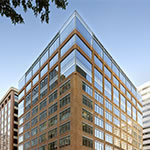Background
The building formerly known as 120 Howard Street is located on the corner of Howard and Spear Streets in San Francisco’s South of Market area. Not that many noticed it. “[It] was one of those buildings whose front door you couldn’t find,” says Michael J. Castro, associate principal and director of architecture at Brereton Architects. This issue, a result of the building’s entryway being off an alley, was something the owner at the time, Beacon Capital Partners, wanted to remedy.
It made plans to extend the lobby to Spear Street, officially changing its address (and name) to 188 Spear Street and, at the same time, expanding the penthouse out to a parapet wall to obtain more rentable space. This had environmental benefits as well as financial ones. “Vertical additions are unique in that they allow you to add density to urban centers within the same footprint,” Castro says.
Challenges
The project got off to a slow start due to three transitions in ownership. Beacon Capital Partners originally approached Brereton, which occupied the rooftop penthouse of the building in 2006. Brereton consulted a structural engineer, Nabih Youssef & Associates (NYA) and learned that the structure appeared strong enough to take on additional load in the form of four additional stories. The architects did some design sketches, but before the project got off the ground, Beacon Capital Partners sold the building to Broadway Partners, which in turn sold it to Shorenstein Company. This was in November 2009, three years after the project began.

The addition brought the property from 143,200 square feet to 218,668 square feet, increasing its net rentable area by 50%.
Additional challenges were still ahead. Brereton would have to design the expansion to achieve LEED Gold certification and do it with the building 40 percent occupied, not to mention convincing officials in the earthquake-prone city that the building could be constructed to meet their stringent seismic codes. But with Shorenstein’s extensive experience working on challenging redevelopment projects, specifically with the City of San Francisco, the project team felt confident it could meet the additional challenges that lay ahead. The project moved forward.
Solutions
Not all existing buildings meet current code, and determining whether 188 Spear Street was one of them was the first step. Michael Gemmell, project principal at NYA, conducted a nonlinear time-history analysis, an electronic model that simulates the last three seismic events to determine how the renovated building would have performed in those events. Gemmell’s study proved to the city that the building met or exceeded current code.
Regarding its sustainability goals, Castro says everyone involved wanted a green building from day one. “When Shorenstein came on board, there was a strong effort to pursue LEED Gold,” he says. The work that needed to be done placed the building on the fine line between LEED Core and Shell and LEED New Construction. Shorenstein went with the former, which allowed it to address more issues specific to the project scope. Nearly 200 windows were replaced with one-inch high-performance glazed windows, which helped with energy efficiency and sound insulation. Shorenstein also replaced a single rooftop fan with a multi-fan array in a stacked configuration. The so-called fan walls—one for incoming supply air and one for outgoing exhaust air—can be shut down depending on airflow needs. “All told, the new 12-story building uses close to the same amount of energy as the old eight-story building,” Castro says.
All this had to be done while the building remained at least partially occupied. Given that the mechanical system had to be replaced and relocated, this was a considerable challenge for Brereton and general contractor Hathaway Dinwiddie Construction Company. Originally, the mechanical system was situated on the roof, but the roof was moving. Plus, Shorenstein wanted to replace it with a new, high-efficiency system. The team framed the new stories but left off certain framing members at the old roof, which would become the ninth floor, and installed the new mechanical system once framing was complete. “It was a complicated procedure,” Castro says, “but it minimized down time, and we completed the switch … over the weekend.”
“The building is a prime example of density management in an urban situation,” Castro says of the completed 188 Spear Street. “We were able to add 50 percent to the building’s net rentable area without increasing the building’s footprint, site, or doing significant demolition.”

